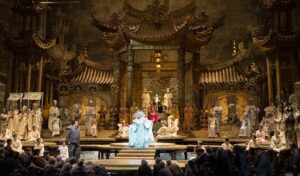
Among the operatic masterpieces throughout history, Giacomo Puccini’s Turandot is one of the most world-renowned works. Puccini’s Turandot also has a fascinating and storied history that can be described as “born global”, because the inspiration for this opera came in a music box brought from another part of the globe, thousands of miles away from Italy.
Thinking Inside the (Music) Box
It has been documented that the inspiration of Turandot came from a music box Puccini received from an Italian diplomat to China at the time, the late-19th century. The music box contained several Chinese melodies, three of which were incorporated by Puccini into the opera. Altogether eight of the themes in the opera are based on traditional Chinese music. In particular, the most recognizable musical theme of the opera is based on the Chinese traditional melody “Mò Li Hūa (茉莉花)” (‘Jasmine Flower’).
Tragically, Puccini wasn’t able to complete Turandot during his lifetime. When Puccini passed away in 1924, he was able to finish the first two of the three acts, and part of the third act only until, coincidentally, the death of Liu, a main character in the opera. The opera was eventually completed by Italian composer and pianist Franco Alfano in 1926.
From La Scala to Forbidden City
Since Turandot’s premiere in 1926 at La Scala in Milan, the piece has been performed around the world, in the grandest opera houses on different continents. One of the most memorable performances was in 1998, when Turandot traveled to Forbidden City, in Beijing, China. To me this was such a surreal performance, because Puccini’s story happened in his imagined Forbidden City in Beijing, known as Peking during Puccini’s time.
On that summer evening in 1998, under the starry night of Beijing, when Turandot appeared on the lofty steps of the almost six-hundred-year-old Taimiao (Imperial Ancestral Temple), outside the Meridian Gate in front of Forbidden City, fantasy met reality, West met East, heritage met modernity.
Perhaps most importantly, at that moment, opera served one of its greatest purposes: bridging different civilizations and bringing humanity together with art, love, and beauty.
This production, documented in the film “The Turandot Project“, was the culmination of collaboration among top artistic talents from around the globe. It was performed by Maggio Musicale Fiorentino, directed by Zhang Yimou, conducted by Zubin Mehta, and performed by a team of artists, with Giovanna Casolla, Audrey Stottler and Sharon Sweet alternating as Princess Turandot.
For a generation of opera fans in China, this was a powerful introduction to opera. In the decades that followed, for Chinese opera fans and beyond, Nessun Dorma might have become as recognizable as Jasmine Flower.
Controversies and Conversations
Despite its great successes, Puccini’s Turandot seems to have an inherent duality. It is almost as celebrated as it is controversial. On one hand, it brings elements from different cultures together. One the other hand, the opera has faced many criticisms, including cultural appropriation, orientalism, and racial stereotyping and discrimination.
These criticisms are important and legitimate, and should be taken seriously. They have also encouraged deep and meaningful reflections, debates, and conversations from diverse perspectives about art, gender, race, culture, and history. These reflections and dialogues may be a valuable gift of Turandot, perhaps unintended by and unknown to Puccini himself, but as important and influential as, if not more so than, the artistic value of the opera.
Reimagination in the Digital Age
Meanwhile, Turandot has continued to inspire creativity and innovation worldwide, even in today’s digital age. For example, while Puccini’s passing left Turandot’s ending incomplete and unresolved, opera composers from different cultures have created different endings based on their own interpretations and imaginations.
In China, Turandot is so well known that a blockbuster fantasy movie called “The Curse of Turandot“, very loosely based on and significant different from, the original story, was filmed and released in 2021.
In Finland, the Finnish National Opera and Ballet (FNOB) incorporated technologies of augmented reality (AR) and virtual reality (VR), or, broadly speaking, “metaverse”, into the latest design and production of Turandot in 2023. This experimentation points to the future convergence of technology and art in opera.
The Fantastical Turandot’s New Adventures
Puccini never lived to see the premier of Turandot, nor did he finish the ending of Turandot. Before Puccini died, he implored the great conductor Arturo Toscanini “Don’t let my Turandot die.”
Puccini’s wish was realized. Since Puccini’s time, with her controversies and flaws, the princess from the imagined realm lived through the ages and episodes of industrialization, globalization, deglobalization, and digitalization. Turandot will probably continue living through the ups and downs of human civilization, in the years to come.
Hopefully, as the fantastical princess navigates the future of humanity, she will continue bringing the world the much-needed beauty, elegance, connectedness, openness, diversity, and dialogues, as she succeeded in doing so over the last almost a hundred years.
***
Alley Oop’s newsletter
Every Friday morning Alley Oop arrives in your inbox with news and stories. To sign up, click here.
If you want to write to or contact Alley Oop’s editorial team, email us at alleyoop@ilsole24ore.com.